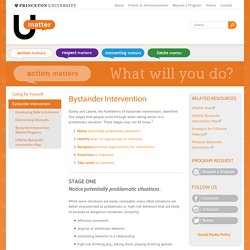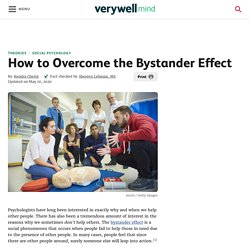

Bystander effect – APA Dictionary of Psychology. The Bystander Effect:The Death of Kitty Genovese. Who were Latane and Darley? AP® Psychology Bystander Effect Review. Skip to content Menu Log In Sign Up AP® Psychology Who were Latane and Darley?

The Albert Team Last Updated On: June 1, 2020 Hey! Educators looking for AP® exam prep: Try Albert free for 30 days! Attention: This post was written a few years ago and may not reflect the latest changes in the AP® program. Introduction to Who were Latane and Darley If you witnessed an emergency, you would certainly help those in need, right? Would You Help Kitty Genovese? New York, March 13, 1964. If this were a scene from a thriller book, it would sound non-realistic. This is why the murder of Kitty Genovese shocked the population in 1964. Their hypothesis was that when we are in the presence of other people, we are less likely to intervene in an emergency.
The Experiments In 1968, Latane and Darley created a situation similar to that of Kitty Genovese’s (but without violence)to understand what social forces were acting on the day of the crime. Next, Latane and Darley divided the participants into three groups: Ethics Defined: Diffusion of Responsibility. Dangerous Conformity. What Is the Bystander Effect? If you witnessed an emergency happening right before your eyes, you would certainly take some sort of action to help the person in trouble, right?

While we might all like to believe that this is true, psychologists suggest that whether or not you intervene might depend upon the number of other witnesses present. What Is the Bystander Effect? The term bystander effect refers to the phenomenon in which the greater the number of people present, the less likely people are to help a person in distress. When an emergency situation occurs, observers are more likely to take action if there are few or no other witnesses. Being part of a large crowd makes it so no single person has to take responsibility for an action (or inaction). In a series of classic studies, researchers Bibb Latané and John Darley found that the amount of time it takes the participant to take action and seek help varies depending on how many other observers are in the room. The Kitty Genovese Case. Untitled. Bystander Intervention.
Darley and Latane, the forefathers of bystander intervention, identified five stages that people move through when taking action in a problematic situation.

These stages may not be linear.1 STAGE ONENotice potentially problematic situations. While some situations are easily noticeable, many other situations are better characterized as problematic or high-risk behaviors that are likely to escalate to dangerous situations, including: offensive comments atypical or withdrawn behavior controlling behavior in a relationship high-risk drinking (e.g., taking shots, playing drinking games). Sometimes, a person’s gut instinct or intuition can be the best cue that a problem exists. STAGE TWOIdentify when it’s appropriate to intervene.
The next step is interpreting the situation as a problem in need of intervention. Is the person acting drunk as a joke, or are they actually intoxicated? You may have to gather more information, for example by: STAGE THREERecognize personal responsibility for intervention. How to Overcome the Bystander Effect. Psychologists have long been interested in exactly why and when we help other people.

There has also been a tremendous amount of interest in the reasons why we sometimes don't help others. The bystander effect is a social phenomenon that occurs when people fail to help those in need due to the presence of other people. In many cases, people feel that since there are other people around, surely someone else will leap into action.1 While the bystander effect can have a negative impact on prosocial behavior, altruism and heroism, researchers have identified a number of different factors that can help people overcome this tendency and increase the likelihood that they will engage in helping behaviors.2 Some of these include: Witnessing Helping Behavior Sometimes just seeing other people doing something kind or helpful makes us more willing to help others.
Breaking the silence - preventing harassment and sexual misconduct. Be an Active Bystander We can all be bystanders.

Every day events unfold around us. At some point, we will register someone in danger. When this happens, we will decide to do or say something (and become an active bystander), or to simply let it go (and remain a passive bystander). When we intervene, we signal to the perpetrator that their behaviour is unacceptable. Bystander Effect: If You Need Help, You'd Better Ask For It. Picture this.

You’re out hiking in the wilderness—all alone and miles from civilization. You turn a corner on the trail and come upon a young man in torn clothes, looking disheveled and a little incoherent. You’re on your way to your campsite, but he clearly needs help. As you approach, he explains he broke his leg, he’s been in the woods for days, and that he’d appreciate it if you could carry him, even just a few meters, to help him get back to the trailhead. What do you do? If you’re a half-decent person, I can guess you chose the first option: to stop and help. So, not only do you help, you probably cancel your plans and help carry the guy all the way back.